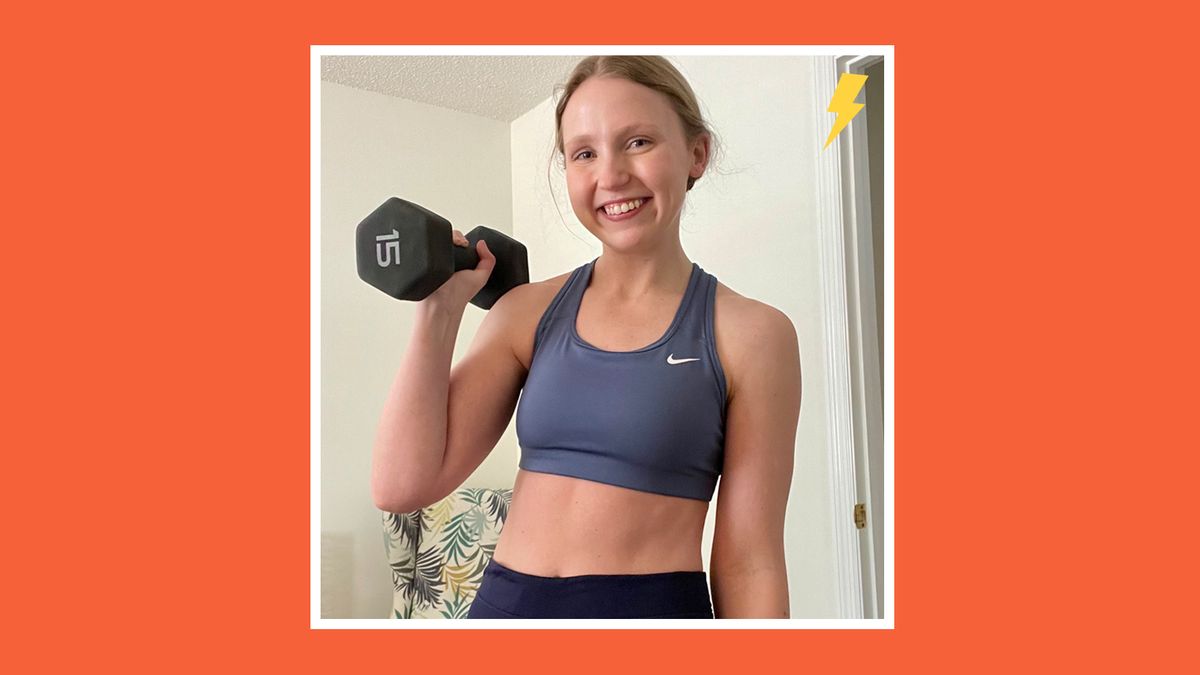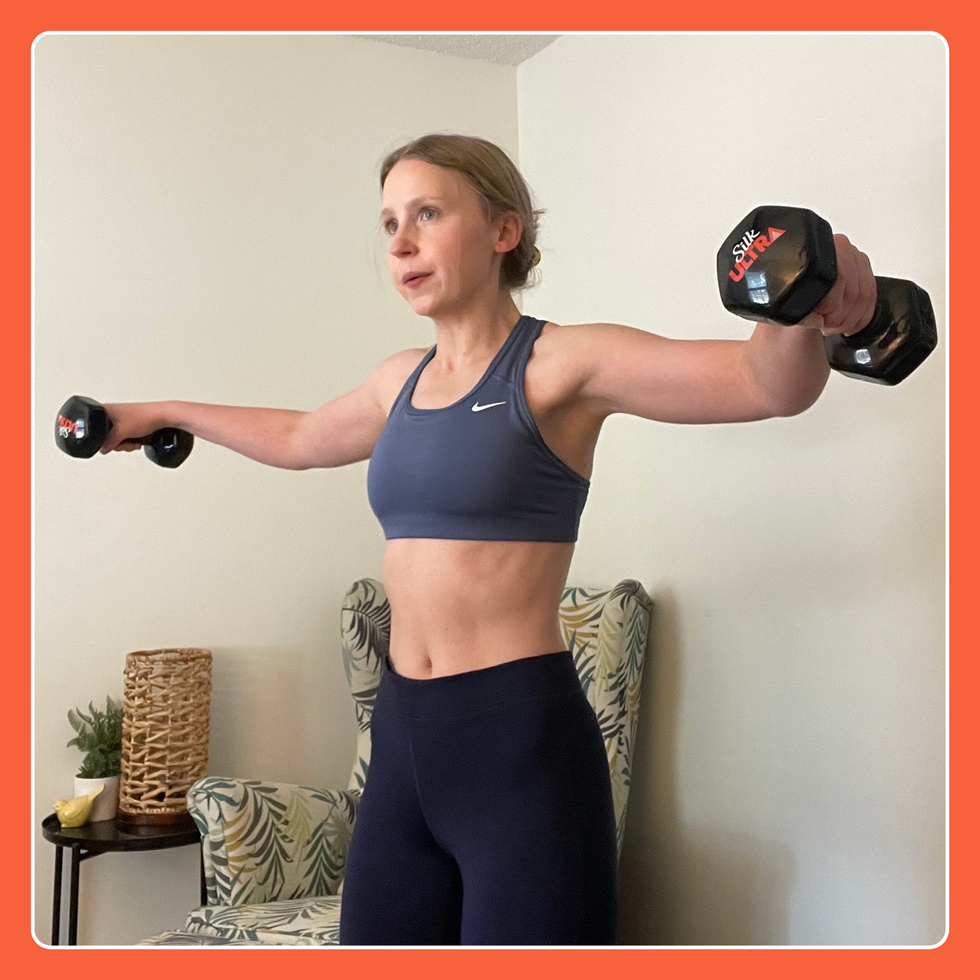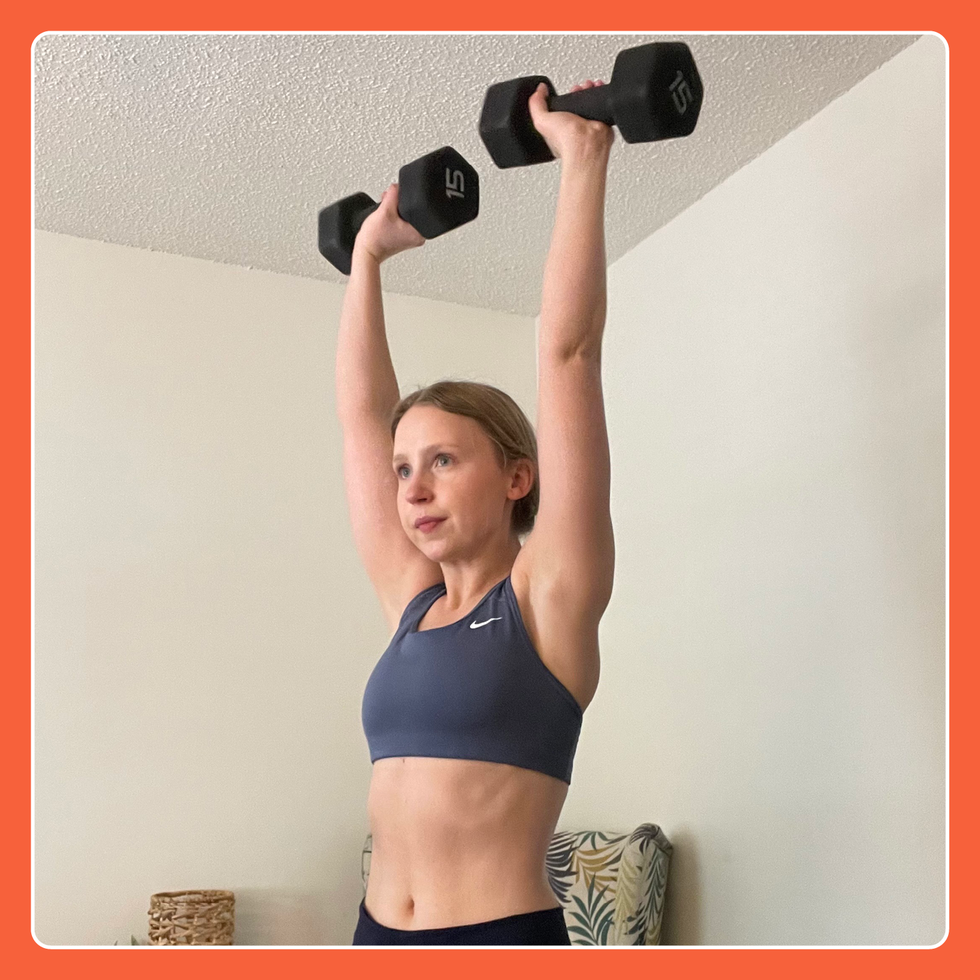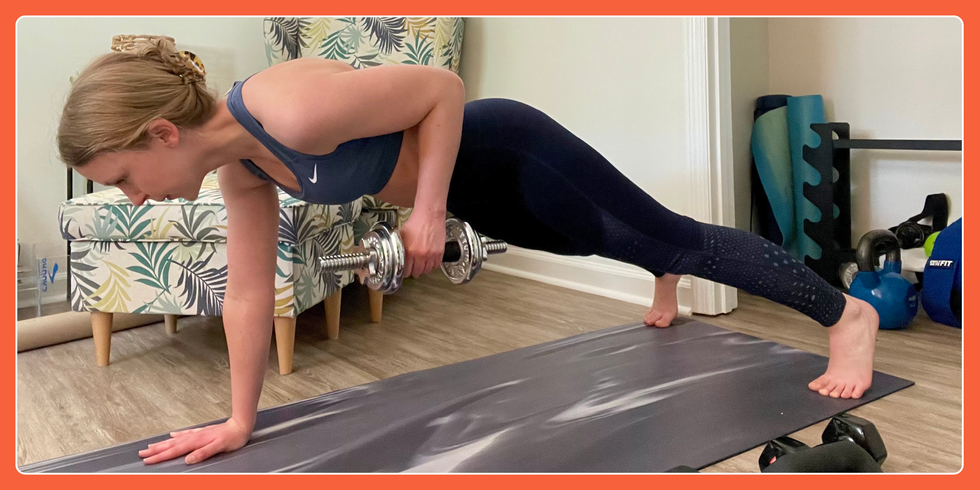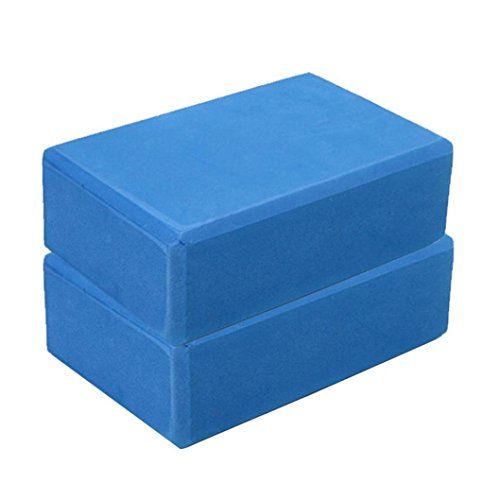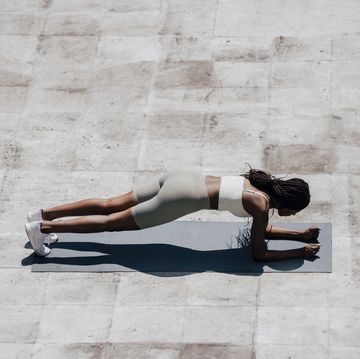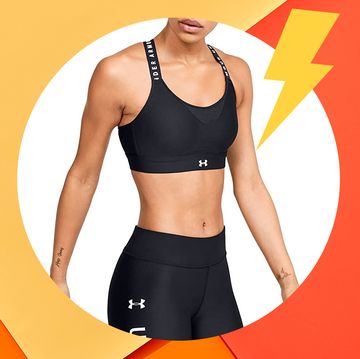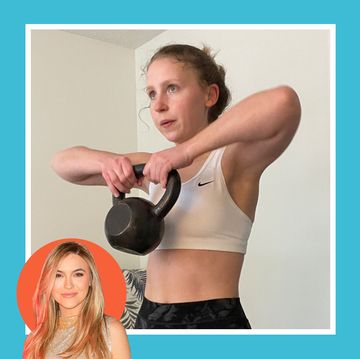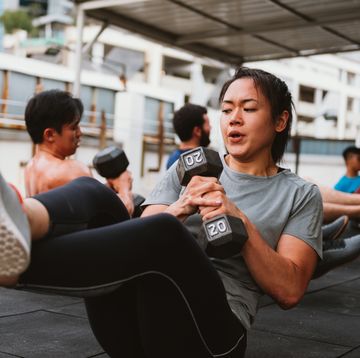When Lucy Liu wants to work up a sweat, she usually opts for SoulCycle classes, runs, or Pilates sessions. Weights were never really in her wheelhouse, but that all changed after she landed a role playing the villain Kalypso in Shazam! Fury of the Gods this spring.
Lucy used to shy away from strength training, partly due to the fear (and myth!) that she would get “too big,” says Lucy's trainer, Jared Kaplan, the founder of Arrive in New York City.
In case you haven't had a chance to check out the newest Marvel movie yet, all you need to know is that Kalypso is a Greek goddess, main antagonist Hespera's (Helen Mirren) villainous younger sister, and a total badass. (Collider even called her character "an instant addition to the canon of campy diva supervillains.")
Lucy wanted to totally embody her powerful character—and that included supporting heavy body armor for 10-plus hours of filming each day—so Kaplan started to introduce more strength into her routine. Luckily, Lucy was open to trying out resistance training, and she ended up falling in love.
Before shooting began, Lucy did a weekly workout program: four days of strength work, (focusing on shoulders and postural muscles to prevent neck strain and spinal compression in her costume), one day of Pilates, and two rest days. Lucy used using the reformer, barrel, and chair to keep herself engaged and help her “decompress,” Kaplan adds.
Weights aside, Kaplan just wanted Lucy to feel good. “Feeling strong and empowered is honestly just more interesting [than aesthetics],” he says.
Lucy Liu's Shazam! Workout Routine
To see what it was like to train like a superhero—err, villain—I tried a month-long version of Lucy’s plan, crafted by Kaplan himself. (Note: I did make a few tweaks to use the equipment I had available.)
The four-week workout plan:
Warm-up: lunges, shoulder circles, light band work, and neck stretch (5 minutes)
Circuit 1: 12-15 reps for 3 sets
Step-up and curl to press
Dumbbell shoulder swim: forward and backward (12-15 reps each direction)
Lateral T raise
Circuit 2: 12-15 reps for 3 sets
Bent-over row
Side plank with single-arm reverse fly
Circuit 3: 12-15 reps for 3 sets
Standing medicine ball lunge twist
Triceps cable press-down
Circuit 4: 30 seconds for 2 sets
Battle ropes: drum, doubles, in and out, circles
Stretch (5 minutes)
At first glance, the program seemed pretty standard to me–I was already doing strength training about four days a week. But by the end of the month, I learned *a lot* and made significant progress both mentally and physically.
Note: You can switch around the order of workouts as needed, Kaplan says. So if you need a break after day two, take a rest day then, for example.
I was more confident in my posture, and more capable of lifting heavy loads. I also felt more comfortable doing a workout style that previously intimidated me. Here are my biggest takeaways after training like Lucy for a full month.
I maxed out my dumbbells and realized I was even stronger than I thought.
Although I typically performed upper-body strength work twice a week, I knew I had not done as much progressive overloading (upping the weights and/or reps to challenge myself) as I could have in the past few months. I’d mostly been focusing on maintaining, not necessarily improving, my strength—and the limited weight options in my home gym made it a bit difficult to continuously test my muscles. But with Lucy's program, I was encouraged to keep amping up the weight.
And it wasn’t easy. For exercises like the renegade row, side plank with one-arm lat raise, and lateral raise, I started with lighter weights to nail my technique. The first time I increased the weight, it was hard, and I couldn’t make it through the set without breaking my form.
But instead of giving up, I focused on what I accomplished, took mini breaks when my technique fell to the wayside, and reduced the weight to finish the final few reps if I was *really* struggling. (Remember, quality > quantity.)
By the end of the program, I was lifting significantly heavier during those three exercises. And for moves like bent-over rows and shoulder presses, I maxed out the dumbbells I had available to me, so I continued to challenge myself by slowing down the eccentric phase of my reps. Cue: serious muscle quivering.
As a lifelong sloucher, the muscle-quivering workouts definitely improved my posture.
I've had “improve posture” written at the top of many New Year’s resolution lists, so I was excited to work on my postural muscles. For a month, I performed countless shoulder presses, lateral raises, rows, reverse flies, and other upper-body movements, progressively overloading them (read: increasing the weight while decreasing the reps to continuously improve strength).
At the end of the month, I noticed my shoulders didn’t round forward as much when I was standing or sitting. I also became more aware of my shoulder positioning. For example, while cooking dinner one night, I realized I was unintentionally holding my right shoulder lifted toward my ear, and I could correct this.
The strength workouts weren’t a magic bullet for stellar posture; after all, it was just a month-long program, and I sit hunched over a computer for most of the day. Still, given the small improvements I made, I'll keep incorporating these movements into my workouts moving forward.
This supervillain-goddess workout reminded me that workouts should have an element of fun.
Although I have my personal training certification and have been writing about fitness for years, I still have so much to learn. That’s why I was pumped to have the opportunity to follow Kaplan's plan and see what types of exercises he enjoys mixing into his programs. There were some moves I'd never heard of, exercise combos I hadn’t thought to program together, and others I completely forgot existed.
During my sessions, I found a handful of exercises that challenged my body in new ways, and I'm psyched to keep mixing them into my workouts. The dumbbell shoulder swim, which was brand new to me, was a perfect warm-up movement that left my joints feeling ~juicy~. I also enjoyed the side planks with one-arm lateral raises and renegade rows—the added dumbbell movements kept my mind off those gruesome plank holds.
Many of the strength-building moves in the program are combination exercises, so you won’t see basic biceps curls or calf raises in the workouts, says Kaplan. “Lucy gets really bored with exercises that are single-minded,” he says. “If it's a one-arm dumbbell raise, she's going to tune out and her mind will start going to what else she has going on that day. So a lot of these exercises go back to full-body integration.”
It’s true: It was nearly impossible to think about upcoming deadlines and all the home improvement projects I need to work on while counting reps for a step-curl-press combo or medicine ball lunge with twists. Love it!
I totally changed my mind about Pilates—and it was *exactly* what my strength routines needed.
I’ll admit, when I first saw Pilates listed on the program, I was hesitant to continue with this trial. I’ve tried a handful of mat classes over the years and found each to be incredibly confusing (what’s the deal with all the pulses, and why are the cues so vague?). But when I voiced these concerns to Kaplan, he explained that I wasn’t alone. In fact, he said that a lot of folks told him they didn’t initially enjoy mat-based classes.
“Pilates on the mat can be way harder than equipment because the equipment can assist you,” Kaplan says. “On the mat, you just have to use your body, so if you have weaknesses, you're going to be facing them head-on.” The Pilates equipment removes some of the weight and makes the workouts more enjoyable for newbies.
Under Kaplan’s guidance, I tried weekly reformer classes (at 7 a.m.!) at a local Pilates studio. By the time this four-week program came to an end, I didn’t want to stop. The low impact workouts meant I wasn't drained before my workday, while still feeling like I challenged *all* my muscles.
Each class, my core went through the wringer, and I was always sore the next day. For that, I have to thank the multiple dead bugs variations, bicycle crunches, and bear planks. My tight hamstrings also appreciated all the stretching.
Overall, the low-impact, endurance-building Pilates classes were the perfect balance with the tough strength workouts. While I didn’t use the barrel and chair that Lucy incorporated into her sessions, I’m excited to continue my Pilates practice and gradually build my skills to get on her level.
Lucy's five workouts per week were intense—so I listened to my body and scaled back.
Thanks to Kaplan's tip to shuffle the workouts, I was able to keep up with the schedule for three weeks. If my shoulders were sore AF, I could rearrange the workouts, focusing on another muscle group to accommodate fatigue. I kept this tip in mind—and I did take advantage of it once or twice.
By week four, I realized that doing five intense workouts a week is simply too much for my body and mind. Having to do five workouts a week felt mentally and physically exhausting at times. Some weeks, I'd tackle the final workout late on Sunday evening (probably without the best form) after pushing it off.
I’ve been doing four weekly workouts for years now, and I'll work in a fifth if I’m feeling particularly motivated or want to switch things up with a cycling class, a slow mobility and stretching session, or a hike. For now, I’ll be going back to optional day-five workouts. For Lucy, the once-weekly Pilates session acted as a bit of a rest day, as the workout is focused more on stretching and decompression, Kaplan told me.
Lucy's intense schedule may work for some folks, but it just wasn’t my jam. I don’t want my training to feel like a chore, but I am glad I tested her program and my bod for a month to see how I felt in different training conditions.
Overall, though, this workout plan was motivating, empowering, and pure fun. While I may not be a critically acclaimed actor, if Lucy needs a stunt double for her next action film, I’m definitely ready to rise to the occasion.
